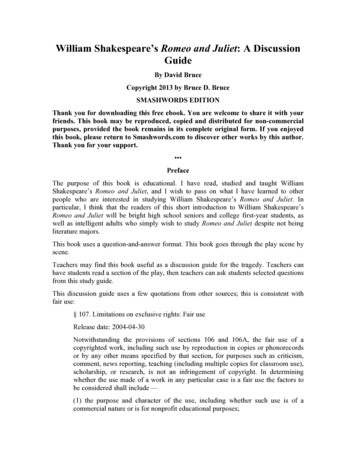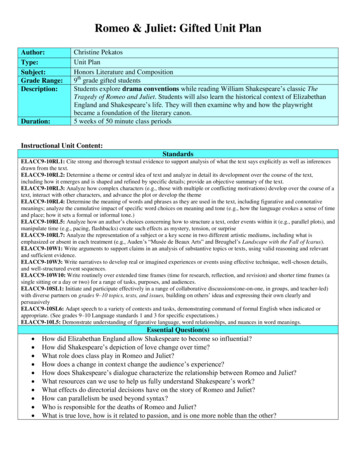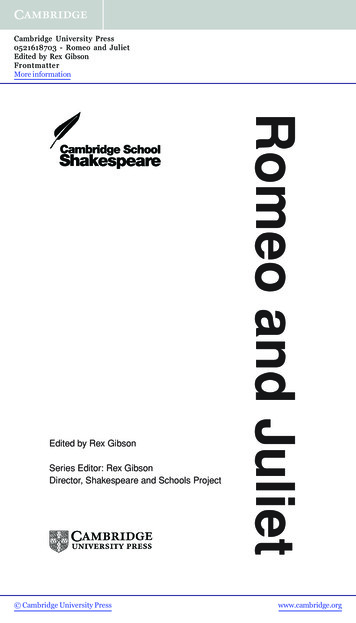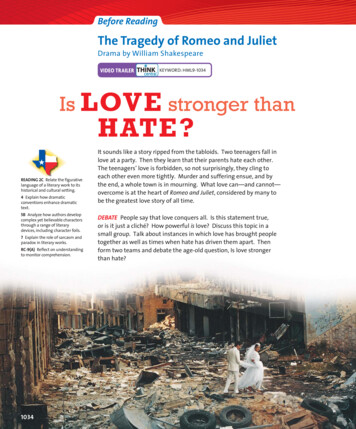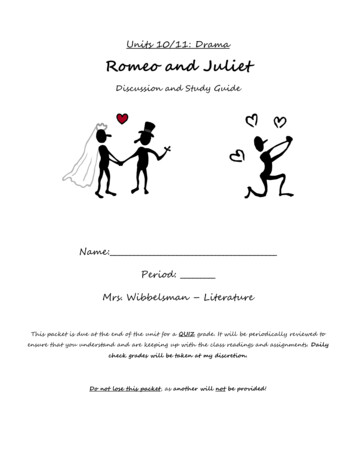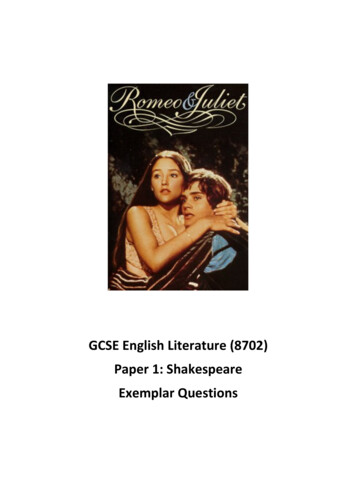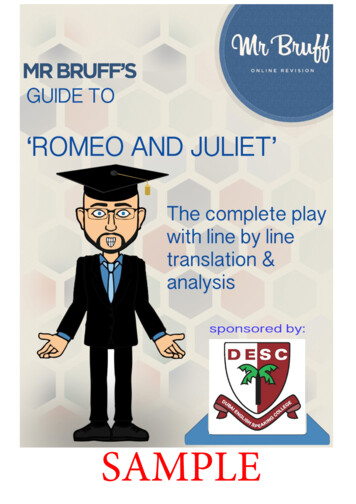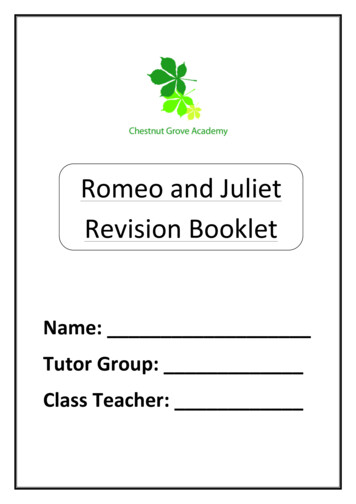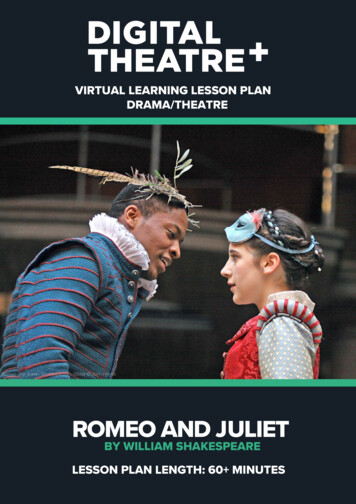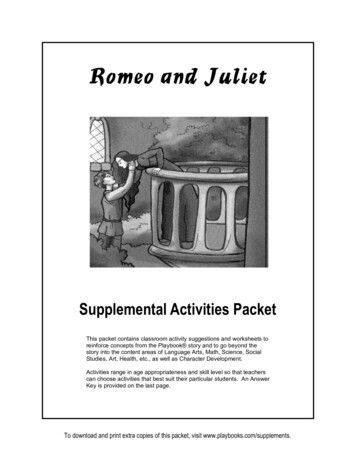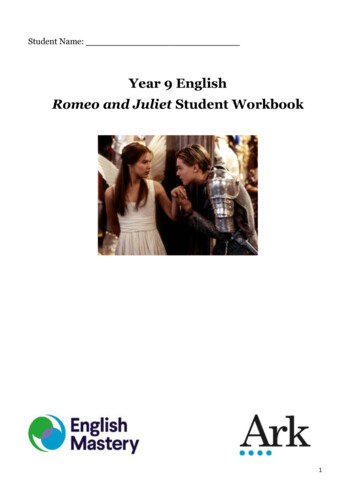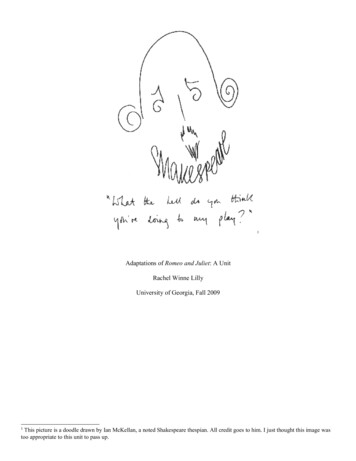
Transcription
1Adaptations of Romeo and Juliet: A UnitRachel Winne LillyUniversity of Georgia, Fall 20091This picture is a doodle drawn by Ian McKellan, a noted Shakespeare thespian. All credit goes to him. I just thought this image wastoo appropriate to this unit to pass up.
Goals and Rubrics
Goals Overview and Point Distribution:I. Unit NotebookVocabulary LogReflective JournalArt ActivitiesNotes180 Points40504040II. Compare/Contrast Paper120 PointsIII. Student Adaptation Project200 PointsIV. Class ParticipationPerformance ActivitiesClass DiscussionThink-Pair-ShareRead-AloudsFilm Casting50 Points10 pts each week550 Points Total
I. Unit NotebookStudents will keep a “Unit Notebook” that will be a collection of the students’ work throughout the unit. TheNotebook will have four sections: Vocabulary Log, Reflective Journal, Art Activities, and Misc. Notes.1. Vocabulary LogIn the Vocabulary Log section, students will keep a record of words that they run across in their readings that theyhad trouble with. They will be required to select 2 words per day Monday-Thursday, with a total of 8 words for that week.In addition to recording the word, students will write down the line of the play where they came across that word, andthen they will write (with the help of a dictionary, a glossary, or a neighbor) a definition in their own words and a sentenceusing that word in a modern context.2. Reflective JournalThroughout the unit, students will be given prompts to write reflective journal responses to. For their responses,students will have 15 minutes to write. After that, students will trade their responses with a partner. They will then have 5minutes to give a response to their peers’ entry. The response must follow the Bless, Press, Address protocol for peerresponse. Students will choose one aspect of the entry to comment on. They may bless that aspect of the entry, meaningthey comment on something that they agree with. They may press that aspect of the entry, meaning they comment onsomething they disagree with. Or they may address that aspect of the entry, meaning they will ask a question aboutsomething in the response that confused them or was not clear.3. Art ActivitiesThroughout the unit, students will be given several opportunities to respond to Romeo and Juliet through artisticexpression. These activities will take many forms, including but not limited to concept maps, “draw what you hear/read”activities, and graphic novel dialogue fill-ins.For “draw what you hear/read” activities, students will listen to either the teacher do a read-aloud or to an audioadaptation of a part of the play. Students will be asked to focus on something in that scene in particular (it could be tofocus on the setting and the physical surroundings of the characters, an important symbol, etc.) and to draw what theyhear. As an example: the teacher will do a read-aloud of Mercutio’s Queen Mab speech. Students will be asked to drawtheir vision of Queen Mab based on Mercutio’s description of her.For the graphic novel fill-ins, the teacher will give students scans from the No-Fear Shakespeare graphic noveladaptation of Romeo and Juliet with the dialogue bubbles blanked-out. Students will then work with a partner to fill in the
dialogue bubbles with their modern English ‘translations’ of the dialogue from the scene. The teacher will then givestudents scans with the dialogue bubbles left intact, so that students will be able to compare their efforts to the original.4. Misc. NotesThis section will be the collection for the other activities and hand-outs for the unit, including but not limited tographic organizers of the themes, symbols, and characters of the play and activities designed to help students withShakespearean English. The students will keep these misc. assignments and notes here in order to keep the studentsorganized and to keep the notes easily accessible.
Unit NotebookDirections:Throughout the unit you will be keeping a Unit Notebook. It will have four sections: Reflective Journal,Vocabulary Log, Art Activities, and Misc. Notes.Your reflective journal entries will be kept in this notebook. You will have roughly 15 minutes to respond to awriting prompt for each entry. Before the beginning of the unit students will select peer-response partners. You and yourpartner will then switch notebooks and write a peer response that follows the “Bless, Press, Address” protocol2. You maybless an aspect of the entry, meaning you comment on something that you agree with. You may press an aspect of theentry, meaning you comment on something you disagree with. Or you may address an aspect of the entry, meaning youwill ask a question about something in the response that confused you or was not clear.For the vocabulary log, you are expected to choose 2 words a day (to total to 8 a week) that confused you inyour reading. For each word, you will write the line of the play that you came across that word, you will then write in yourown words (with the help of a dictionary) a definition for that word, and then write a sentence using that word.Throughout the unit we will be doing art activities. There will be roughly four or five of these activities, andthey will either be dialogue-fill-ins for a graphic novel, or they will be “Draw What You Hear” activities. Both of theseactivities require an attention to detail and good listening skills.The rest of the notes (including graphic organizers and worksheets) will be put into the Misc. Notes section.They should be organized either by category (meaning all graphic organizers go together, all language activities gotogether, etc) or chronologically.Rubric:Reflective Journal:X8WrittenResponses5There is one clear,well-focused topic foreach entry. Main ideastands out and issupported by detailedinformation.Relevant, telling,quality details give thereader importantinformation that goesbeyond the obvious orpredictable.24Main idea is clear ineach entry but thesupporting informationis general.Supporting details andinformation arerelevant, but one keyissue or portion of thereflection isunsupported.3Main idea is somewhatclear in each entry butthere is a need formore supportinginformation2The main idea is notclear in the entries.There is a seeminglyrandom collection ofinformation.Supporting details andinformation arerelevant, but severalkey issues or portionsof the reflection areunsupported.Supporting details andinformation aretypically unclear or notrelated to the topic.I was introduced to the “Bless, Press, Address Protocol” for peer feedback by Dr. Bob Fecho of UGA.
X25432Peer Responsesin Partner’sJournalThe student follows the‘Bless, Press, Address’Protocol and has atleast one response forbless, press, andaddress.The response to thejournal is thoughtfuland insightful. Thepeer response improvesupon the original entry.The student follows the‘Bless, Press, Address’Protocol and has atleast one response forbless, press, andaddress.The response to thejournal is clear,focused, and wellthought out.The student follows the‘Bless, Press, Address’Protocol. The studentneglected to try outeach option (bless,press, address) at leastonce.The response isfocused, but does notadd much to thedialogue.The student does notfollow the ‘Bless,Press, Address,Protocol.’The response hasalmost nothing to dowith the original entry.It is either pointless orchatty./ 60Rest of the Notebook:X8Vocabulary LogArt ActivitiesMisc. Notes5There are 8 words foreach week.The log is clearlyorganized and easy toread.All requiredcomponents (word,line from the play,definition, and newsentence) arecompletedmeaningfully.All of the art activitiesare completed.The artwork and wordplay is creative,focused, detailoriented, anddemonstrates athoroughunderstanding of theplay.The notes arethorough andorganized. All of thegraphic organizers andworksheets arecomplete and filledwith details. Thesenotes could be used asa class example.4There are 7-6 wordsfor each week.The log is organizedand easy to read. Mostof the requiredcomponents (word,line from the play,definition, and newsentence) arecompleted.3There are 5 words foreach week.The log is not wellorganized or is hard toread. A majority of therequired components(word, line from theplay, definition, newsentence) arecompleted.2There are four or lesswords for each week.There doesn’t seem tobe any organization.Less than half of therequired components(word, line from theplay, definition, newsentence) arecompleted.Most of the artactivities arecompleted.The artwork and wordplay is creative andmeaningful effort ismade. However, theactivity may belacking in attention todetails.The notes are wellorganized and neat.Most of the graphicorganizers andworksheets arecomplete. If thesenotes were shared,they would help otherstudents improve theirgrades.A majority of the artactivities arecompleted.The artwork and wordplay shows a basicunderstanding of theplay.Less than half of theart activities arecompleted.The artwork and wordplay do not relate backto the play at all. Theyare pointless exercises.Clearly no effort wasmade.The notes are not verywell organized, orthey are not very neat.A majority of thegraphic organizers andworksheets arecomplete. The noteswould be helpful forthe student but not forothers.There does not seemto be any method oforganization. Lessthan half of thegraphic organizers andworksheets arecomplete. The notesare unhelpful andincomplete./ 120Total Points / 180
II. Compare/Contrast PaperEvery Friday, the class will have a film day, where we will watch the Zeffirelli and the Luhrmann adaptations ofRomeo and Juliet. These viewing will be “guided viewings” much like our readings in class are “guided readings” wherewe will pause at times and discuss what we are watching. Students will be given charts to organize their notes about theadaptations (see below). These notes will be essential for their compare and contrast essay. On the same days that wewill be watching the films, students will also be going through the different stages of the compare and contrast processoutlined in Dynamics of Writing Instruction, “Chapter 6” to practice writing compare and contrast papers before tacklingthe task of comparing and contrasting the two adaptations. Students will then have a few instructional days to go throughthe process of writing their compare and contrast papers, including a rough draft and peer conferences.
Compare and Contrast PaperDirections:Throughout the unit we have been taking notes over the Zeffirelli and the Luhrmann adaptations of Romeo andJuliet. Your task is to go through your observation notes and use them to write a comparison and contrast paper where youmake an argument for which adaptation is the best adaptation. The paper should be, at minimum, two pages long, singlespace, front-side only.You will have time to write a rough draft as well as to have a peer conference (with the same person that you arepartners with in the reflective journal) and to make revisions before writing your final draft to turn in to me.Remember the stages of comparing and contrasting: identify, characterize,prioritize, compare and contrast, and make a value judgment.Rubric:X6Comparison andContrastEvaluation/ 605The writersuccessfully usesseveralreasons/appeals to tryto show why thereader should care orwant to know moreabout the topic.The paper statessufficient facts toshow similarities.The paper statessufficient facts toshow differences.The writer makes aclear and wellsupported judgmentabout the adaptations.The writer includesplenty of relevantdetails and facts tosupport their position.They think of possiblecounter-argumentsand effectively rebutthem.Content4The writersuccessfully uses oneor tworeasons/appeals to tryto show why thereader should care orwant to know moreabout the topic.The paper states somefacts to showsimilarities.The paper states somefacts to showdifferences.The writer makes aclear and reasonedjudgment about theadaptations. Thewriter includes somedetails and facts tosupport their decision,but some points areleft withoutjustification. Thewriter has thoughtabout possiblecounter-arguments,but does noteffectively rebutthem.3The writer attempts tomake the reader careabout the topic, but isnot really successful.The paper only statesone similarity.The paper only statesone difference.2The writer made noattempt to make thereader care about thetopic.The paper states nosimilarities.The paper states nodifferences.The writer makes ajudgment about theadaptation withsupporting details andfacts. However, thejudgment isinconsistent. Thewriter makes noindication that theythought about anyopposing arguments.The writer gives anopinion, not aninformed judgment.There are little to nosupporting details orfacts .
X4Conventionsand WordChoice5Writer may have madesome surface errors,but they do not hinderthe reader fromunderstanding thecontent. Writer usesvivid words andphrases that linger ordraw pictures in thereader's mind, and thechoice and placementof the words seemsaccurate, natural andnot forced.Style and Process43Writer not only hasWriter makes surfacesurface errors, but they errors and many errorsalso have some errorsthat are serious enoughthat are serious enough to distract the readerto hinder the readerfrom the content of thefrom understanding the piece. This piece wouldpoint being made.have benefited fromWriter uses vividmore careful revisionwords and phrases that and editing.linger or draw pictures Writer uses words thatin the reader's mind,communicate clearly,but occasionally thebut the writing lackswords are usedvariety, punch or flair.inaccurately or seemoverdone.OrganizationPaper follows aconsistent order; breaksinformation intointroduction,compare/contrast,evaluation, andconclusion.Paper follows a fairlyconsistent order; breaksinformation intointroduction,compare/contrast,evaluation, andconclusion.Paper order isinconsistent; Somedetails are not in theexpected order.Rough DraftThe rough draft iscomplete. Evidence ofthorough editing andrevision is present.The rough draft ismostly complete and itis clear that there hasbeen editing andrevisionThe rough draft iseither incomplete orshows a lack of editingand revision./ 60Total Points / 120Comments:2Writer makes so manyserious errors that thereader has troublefollowing the train ofthought through mostof the piece. It is clearthat there was norevision or editing.Writer uses a limitedvocabulary that doesnot communicatestrongly or capture thereader's interest. Jargonor clichés may bepresent and detractfrom the meaning.Many details are not ina logical or expectedorder. There is littlesense of organization.The paper is confusing.There is no rough draft.
III. Student Adaptation ProjectNow that students have had the chance to evaluate two different adaptations of the play, they now have the task ofmaking their own adaptation with other students. Students will break into groups of four to five. Each group will beresponsible for putting on a puppet show for the class. In addition to putting on the puppet show, each group will be askedquestions about their adaptation choices by their instructor and by their classmates. Between the performance and thequestion and answer session, each group will have about 10 minutes. This next part will not be graded, but every studentwill be given a pack of index cards. They are to write a 2-3 sentence ‘review’ of each performance that they see, givingthe reviews to me. I will compile the commentary for each group and give them to the group members with their grades.
Puppet ShowDirections:As a group, you will be putting on a puppet show adaptation of Romeo and Juliet for your classmates. You areencouraged to use your collective imaginations to expand the vision of your play beyond a traditional transcription of theplay. You are expected to write your own dialogue in your own language (meaning non-Elizabethan English).Everyone will have 3 and ½ class periods to complete the project.You have a lot of creative freedom for your adaptation, but you must be prepared to answer questions fromyour teacher and your classmates to explain and support your adaptation decisions.Rubric:X55Comprehension The adaptation and theresponse to questionsreflect understandingthe plot features of theoriginal play or scene,including nuances.Adaptation reflectsunderstanding ofcharacterization,themes, motifs andother literary featuresof the original scene.OriginalityProject is unique, doesnot look like theothers. Showscreativity that works, itis not just weird butexciting and fresh.Project displaysinventiveness, oftenwith unexpected twistsor surprises. Uniquepersonalities of authorsare highly reflected.DialogueDialogue developscharacter, advancesplot, and providesinformation in regardsto past, present, andfuture. Dialoguecontains both text andsubtext.Play and Script4The adaptation and theresponse to questionsreflect understandingof major events in theoriginal play or scene.Adaptation reflectssolid understanding ofcharacterization andthemes of the originalscene.Project is nice andworks, but is notunique. It has similarcomponents as otherpresentations. Thepersonalities of theauthors are present inthe work.Dialogue developscharacter, advancesplot, and providesinformation.3The adaptation and theresponse to questionsreflect understandingof most events in theoriginal play.Adaptation reflectssome understanding ofcharacterization andthemes but few otherliterary aspects of theoriginal play or scene.2The adaptation andresponse to questionsreflects minimalunderstanding of plotfeatures of the originalplay or scene.Adaptation reflectsminimal understandingof characterization andthemes in the originalscene.Project appears forced,hard to follow. Has toomany parts that arestrange and do notserve any purpose.Tried to be creative butdoes not work. Theproject was so focusedon including uniquethings that it does notinclude thepersonalities of theauthors.Dialogue does not doenough. Either doesnot develop character,advance plot, orprovide information.There are minorinconsistencies.Project shows noattempts at creativityor originality. It isbland and does notillicit any excitementfrom the audience.There is no personalityof the authors present.Dialogue hurts theplay. It is off topic andpointless. There is noconsistency.
Conventionsand WordChoiceWriter may have madesome surface errors,but they do not hinderthe reader fromunderstanding thecontent. Writer usesvivid words andphrases that linger ordraw pictures in thereader's mind, and thechoice and placementof the words seemsaccurate, natural andnot forced.Writer not only hassurface errors, but theyalso have some errorsthat are serious enoughto hinder the readerfrom understanding thepoint being made.Writer uses vividwords and phrases thatlinger or draw picturesin the reader's mind,but occasionally thewords are usedinaccurately or seemoverdone.Writer makes surfaceerrors and many errorsthat are serious enoughto distract the readerfrom the content of thepiece. This piecewould have benefitedfrom more carefulrevision and editing.Writer uses words thatcommunicate clearly,but the writing lacksvariety, punch or flair.Writer makes so manyserious errors that thereader has troublefollowing the train ofthought through mostof the piece. It is clearthat there was norevision or editing.Writer uses a limitedvocabulary that doesnot communicatestrongly or capture thereader's interest.Jargon or clichés maybe present and detractfrom the meaning./ 100PerformanceX5Puppets5Puppets are creativeand well constructed.It appears that thestudents spent time onpuppets and tookpride in their work.4Puppets are wellconstructed and readyon time, but theycould have been morecreative.FluencyStudents are clearlyfamiliar with the playand their lines. Theystay in character anddo not stumble.Students haverehearsed.Students are familiarwith most of the playand their lines. Theystay in character butstumble over some oftheir lines.EnthusiasmThe student displaysenergy and creativityin all elements of theperformance and isvery enthusiastic allof the time.The student displaysenergy and creativityin most elements ofthe performance andis enthusiastic most ofthe time./ 753Puppets are ready ontime, but the studentscould have spent moretime making thepuppet. They are notneat, well constructed,or creative.Students are not wellprepared for theperformance. Theyhave trouble stayingin character andsaying their lines.They might goof offand go off script.The student displaysenergy and creativityin some elements ofthe performance anddisplays enthusiasmsome of the time.2Puppets are not readywhen class starts andis thrown together atthe last minute.Students clearly didnot put effort intocreating the puppets.Students are clearlyreading their linesduring theperformance for thefirst time. Theystumble and do notstay in character.They are off taskduring the play.The student displaysenergy and creativityin a few elements ofthe performance andis rarely enthusiastic.
Group DynamicsFor this portion of the project, you will receive three grades that will total up to 25 possible pts.InstructorPeerSelfExpectations13 points6 points6 pointsThe student isessential for thesuccess of the group.They stay positive andconstructive with theirgroup members. Theycomplete their workon time and well andhelp others.9 points4 points4 pointsThe student has apositive impact on thegroup. Theyparticipate with groupwork and discussions.They complete theirwork on time andwell.5 points2 points2 pointsThe student does notparticipate in anygroup discussions orgroup work, but theycomplete their ownwork for the group ontime. They neitherhelp nor hurt thegroup much.2 points***1 point1 pointThe student harms thegroup overall withtheir negativity. Theydo not cooperate withtheir group membersand they do notcomplete their workon time./ 25Total Points / 200***Anyone whose peers score them with 1 point will receive a failing grade. For the sake of fairness, they will notbenefit from the hard work of their peers if they do not contribute anything to the group product.Comments:
Group SheetTake a look at the Group Dynamics section on your rubric sheet. Think about how you and your group membersindividually contributed to the project and under which column you and your group members would fall.Please score yourself (5, 4, 2, or 1). and describe here in detail what you individually contributed to the project.Name:Score:Contributions:Please list here the names of you group members and the score that you would give them (5, 4, 2, 1).Please also give a brief (2-3 sentence) explanation as to why you are giving them that score. If you need more space, writeon the back of this nName:Name:Score:Score:Explanation:Explanation
IV. Class ParticipationStudents will have a variety of opportunities to participate actively in class. Most days, for example, the class willstart with a short engagement activity, often a drama exercise. Students can also volunteer for read-alouds or to presenttheir group’s work for the class. Their participation requirement can also be fulfilled through asking good questionsduring class discussion. The students will not be required to do all of these things in order to fulfill the class participationrequirement, but they are responsible for finding ways to actively contribute at least once a week. There is no rubric forclass participation. However, I will keep a running log of simple check marks.
Participation LogDates: toActivity and DateStudentName
Rationale
Classroom RealitiesWhile developing this unit, I had to negotiate between two different desires: the desire to create a unit that I coulduse while I am student teaching at Apalachee High School and the desire to create a unit that is not so contextualized inmy current situation that I would not be able to use it after moving on. In other words, I wished to take into account therealities of my current situation without becoming completely restrained by them. For example: my mentor teacher placesa strong emphasis on developing vocabulary, and she works towards that goal through giving a weekly list that shereviews daily with students using different teaching strategies and quizzing them at the end of the week. So I wished toaddress and respect my mentor teacher’s focus on vocabulary development, but I also wanted to explore other methods ofaddressing that focus (see the vocabulary log part of the Unit Notebook project for more information).The other realities of my teaching environment that I needed to take into account while developing this unit are: The students I am student-teaching are 9th grade, on-level learners, whose reading abilities cross a wide spectrumfrom 4th grade reading levels to 12th grade reading levels. Assigning homework or out-of-class reading is discouraged at the high school I am student-teaching in. Thusmost of the text of Romeo and Juliet must be read in class, and class time must be dedicated towards any of themajor projects in the unit. Apalachee High School runs on a block schedule. Each period that I will be planning for is 90-minutes long.Overarching Beliefs and Learning GoalsI have five overarching beliefs about learning and teaching that drastically impacts this unit, and they are: Shakespeare is worth teaching to high-school students. Furthermore, Shakespeare's works are meant to beobserved and performed, not read. Reading is an essential first step to this process, but not the final one. Not all knowledge in the classroom should be prescribed from teacher to student. On the whole, knowledgeshould be constructed through a collaborative process. A text is not static. Every student has a unique combination of skills, abilities, and funds of knowledge thatinfluence their understandings of a text. There are multiple intelligences (or ways of knowing and expressing what one knows) that should be valued inthe classroom. Students not only deserve but need to have a hand in their own learning. They need to learn how to assess theirown and their peers’ skills and abilities (not just know how teachers assess them).
There are compelling arguments against teaching Shakespeare to high school students. The most oft-citedargument is that the language and the worlds in Shakespeare’s plays are too far removed from the experiences ofcontemporary high school students. Indeed, I will not argue that some aspects of Shakespeare’s language and culture areirrelevant to (or at least very removed from) us as a current society. There are entire passages, for example, filled withjokes and puns that only the most scholarly of Shakespeare’s enthusiasts can chuckle at. Yet I cannot fully endorse theargument, even though I recognize the difficulties inherent in teaching Shakespeare (especially since we can simply skipthose aforementioned passages if we believe them to be inessential). If we look at Shakespeare’s works thematically, if wetry to look beyond the language barriers, we can see many issues that are still salient to us and to our students today.Romeo and Juliet is particularly relevant to adolescents: you have a young woman (Juliet) maturing rapidly before oureyes, gang violence, young love, testing boundaries of friendship, clashing with one’s parents and with society, andquestions of fate vs. free will. Also, if you provide students with enough time and scaffolding, Shakespeare’s languagecan seem less intimidating (especially if you approach learning the language through play rather than through filling inworksheets!).So I believe that many of the themes in Romeo and Juliet are timeless, and that if we can help students over thelanguage wall that we will have a treasure-trove of learning opportunities in the classroom. Yet there is more tountangling the language and purpose of Shakespeare’s writing than decoding the words. Shakespeare’s works are plays,not books, and Shakespeare was a dramatist, not a novelist. His works are meant to be adapted (and Shakespeare himselfwould cut and add scenes to his performances not in the original drafts) and performed for an audience. Meaning isconveyed in these works not just through words but through body language and voice inflection. So for students to trulywork with Romeo and Juliet, they must perform and see others’ adaptations of Romeo and Juliet. As an example: Juliet’sline “You kiss by the book” can mean two different things, depending on how the actress says that line. She can say itwith awe in her voice, meaning that Romeo’s kissing is spot-on. Or she can say the same line with a wry inflection, andsuddenly we understand the line as Juliet teasing Romeo for kissing as if he read about how from a book but never hadpracticed it on an actual person.When I say that students will be performing Shakespeare, I do not mean that students will be putting on a fullfledged production of the play nor do I mean that they will be sitting in rows doing read-alouds all class period (thoughthose are viable options). Instead, they will have different activities that allow them to first read the work, then drawconclusions from their reading, and then translate those conclusions into a method of performance. Essentially, I am
employing the definition of performance-based teaching created by the Folger Shakespeare Library, which is: aninteractive approach to the study of literature, particularly Shakespeare's plays and poems, in which students participatein a close reading of text through intellectual, physical, and vocal engagement. They might mime a scene, using theirbodies to reflect their interpretations of a character, or work on reading lines with subtext. Moreover, students must beprepared to justify their choices and to explain their interpretations. The students will also engage in critical thinking skillsby analyzing the choices made by others (specifically, the choices made by those involv
1 Adaptations of Romeo and Juliet: A Unit Rachel Winne Lilly University of Georgia, Fall 2009 1 This picture is a doodle drawn by Ian McKellan, a noted Shakespeare thespian. All credit goes to him. I just though
